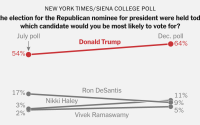The U.S. Population Is Older Than It Has Ever Been
What’s New
The median age in the United States reached a record high of 38.9 in 2022, according to data released Thursday by the Census Bureau.
It’s a rapid rise. In 2000, the median age was 35, and in 1980, the median was 30.
Why It Matters: The nation is aging and having fewer children.
While many 38-year-old millennials may still feel young, that age is an unusually high median for the country.
The new data adds to the evidence that, like many European and Asian nations, the United States is graying, posing challenges for the work force, the economy and social programs.
Low birthrates are the main driver of the nation’s rising median age, experts said.
“It’s simple arithmetic,” said Andrew A. Beveridge, president of Social Explorer, a demographic data firm. “Fewer kids are being born.”
Birthrates fell steeply in the first year or so of the coronavirus pandemic. Since then, they have ticked up. Still, since the beginning of the Great Recession, in 2007, fertility has remained very low compared with previous generations.
The trend is international, even affecting countries with much stronger social programs than the United States, like Norway, Sweden and Finland, which heavily subsidize child care.
Across industrialized nations, women of the millennial generation have been more likely to prioritize education and work in their 20s, leading to them marrying older and having fewer children, according to researchers.
Among states, Maine (44.8 median age) is the oldest, with New Hampshire (43.3) not far behind.
Utah (31.9), the District of Columbia (34.8) and Texas (35.5) are the youngest, according to the Census Bureau.
Among counties with populations over 100,000, the oldest was Sumter County, Fla., where The Villages retirement community is partially based. The median age there was 68.1. The youngest large county was Utah County, home to the city of Provo, with a median age of 25.7.
Not coincidentally, Utah has some of the highest fertility rates in the nation.
Background: A nation of immigrants with sluggish immigration rates.
The new census data covers the period up to July 2022.
And while it shows the American population is older than it ever has been, the nation remains younger than its peers in Europe, where the median age is 44, said Kenneth Johnson, a demographer at the University of New Hampshire.
Immigration has historically kept the United States young, as immigrants are generally working-age adults and often have more children than native-born Americans. While immigration has recovered from rock-bottom levels during the pandemic, it has, overall, slowed since 2016.
What’s Next: A more diverse America.
As the nation ages, it is also becoming more diverse. Between 2021 and 2022, the nation’s Asian population grew by 2.4 percent; the Hispanic population by 1.7 percent; the Black population by 0.9 percent; and the white population by 0.1 percent.
The Native Hawaiian Pacific Islander population increased by 1.8 percent and the American Indian population increased by 1.3 percent.
Southern and Western states have attracted the most new residents in recent years, and those states are also some of the most dynamic demographically, according to the new census data.
Among large counties, Kaufman County, Tex., a booming exurb of Dallas, had the nation’s fastest-growing Black population, growing by 21 percent — over 6,000 residents — between 2021 and 2022.
The median age there was a relatively youthful 33.9 last year.


